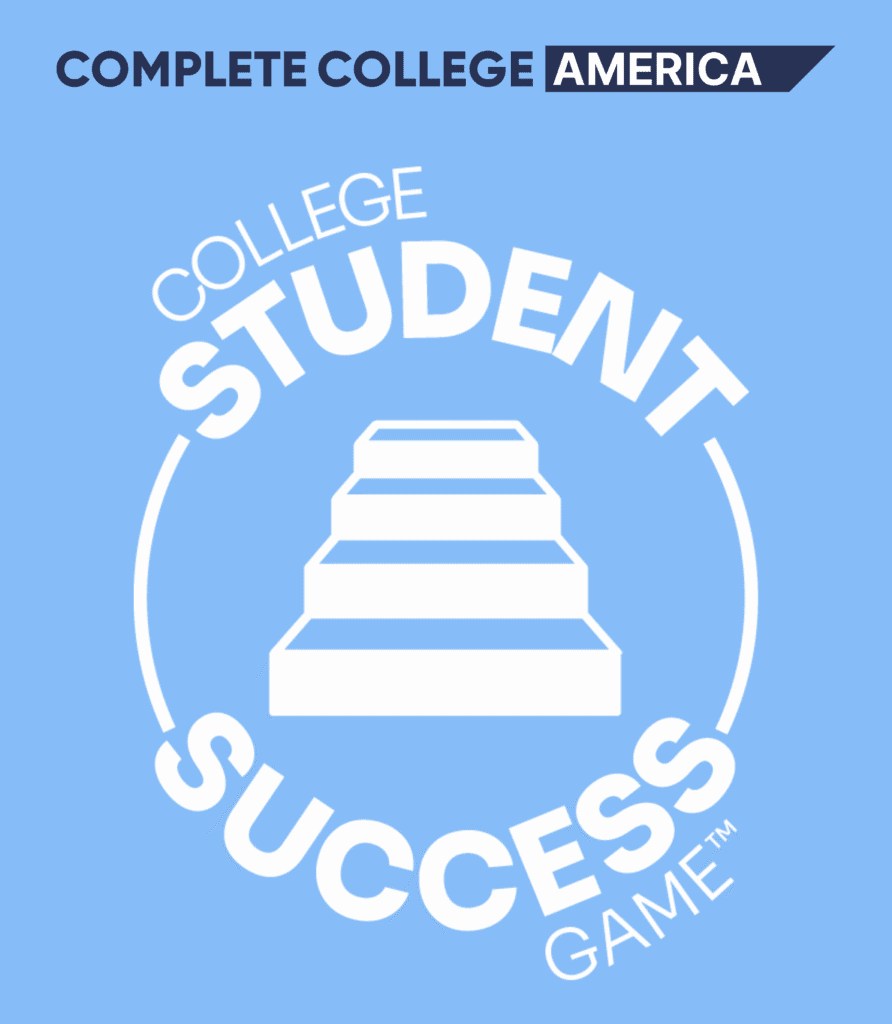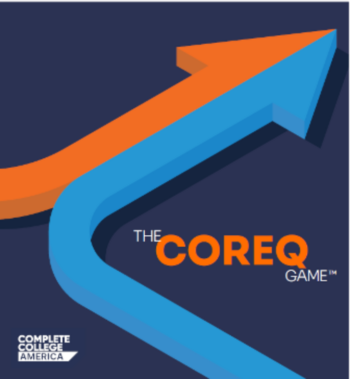Step into the shoes of a student entering college.
What obstacles will you encounter?
What supports might help you?
Complete College America’s games provide college leadership, faculty, staff, higher education researchers, and non-profit organizations the opportunity to experience the journey toward college completion through a first-person, immersive experience. The games recreate the challenges, resources, and achievements students will encounter during their undergraduate experience while illuminating the roles that colleges and universities play in student success.
The College Student Success Game™
Click for resources and downloads

Take on the role of a student and try to move toward earning a postsecondary credential.
- How far can you advance in four semesters?
- Can you find the academic support you need to pass all of your classes?
This game is best played with four to six players. With this group size, all players will be able to see a range of experiences emerging over the course of the game.
The COREQ Game™
Click for resources and downloads

It’s your first semester, and you have to pass a gateway math or English class.
- How many semesters will it take you?
- How will your initial placement — in traditional prerequisite remediation or corequisite support — affect your success?
Each box comes with five playable copies of the game, allowing up to six people to play simultaneously, with a total of up to 30 people able to play at any given time. A great activity for professional development or other gatherings with large groups!
Interested in getting your own copy of a CCA Board game?
Let us know if you are interested in ordering The College Student Success Game™ or The COREQ Game™.
The Research Behind the College Student Success Games
Why is the game structured in this way?
Why do corequisite students have an advantage in the game?
- In a rigorous observational study done in Tennessee, students who took part in corequisite were found to be more likely than those in developmental courses to complete College-Level math by more than 20 percentage points and College-Level English by 15 percentage points within their first year. (Ran & Lin 2022)
- A Randomized Controlled Trial (RCT) in Texas with 1,276 participants found that students assigned to corequisite English were 24 percentage points more likely to have passed College-Level English within their first year when compared to students who took standard remedial English classes. (Miller et al. 2022)
- An RCT in New York with 917 participants found that students assigned to college-level statistics with corequisite support were 16.5 percentage points more likely to pass that course than students assigned to remedial elementary algebra (Logue et al. 2016).
- Corequisite students in that RCT were 50 percent more likely to complete their Associate’s degree within three years, and 100 percent more likely to complete their Bachelor’s degree within five years (Douglas et al. 2023).
Why do pre-requisite students have a disadvantage in the game?
- Sanabria et al. (2020) used nationally representative survey data to examine students at 2- and 4-year colleges. Findings showed that those who failed remedial coursework were less likely to graduate and earned less from wages than similar students who did not take remediation.
- Substantial proportions of new college students are required to take developmental or remedial courses in English and mathematics before proceeding to college-level work (Chen & Simone, 2016). Most remediation occurs as a single pre-requisite course or a sequence of pre-requisite courses (Logue et al. 2016).
- 2012 data from California’s community college system indicated that less than 20 percent of students assigned to the longest developmental English sequence complete college-level English within three years. For those assigned to the lowest level of developmental mathematics, the rate was just 6 percent (Hern & Snell, 2014).
- Students from low-SES backgrounds are more likely to be assigned to developmental courses (Chen & Simone, 2016).
- Students from racially minoritized populations are disproportionately assigned to remediation in general (Logue et al. 2019), and to the lowest levels of remedial sequences (Perry et al. 2010).
- Entering community college students are commonly placed in a lower level of mathematics than they completed in high school. A study of 80,000 California high school students who entered community college from 2005 to 2014 found that 92 percent repeated a math class level they had completed in high school at least once, with 53 percent having to repeat two or more times (Ngo & Velasquez, 2023).
- The same study indicated that 48 percent of students in this sample who enrolled in a college math course never reached the highest level of math they completed in high school, which they termed a “Math Trap.”
How did you determine what to include in the challenge/support/pedagogy cards?
Basic Needs Support
- Students’ retention, persistence and completion in college are often determined by personal factors unrelated to academic preparation or performance. Access to physical and mental healthcare, technology, food and housing security, reliable transportation, and steady childcare can all play a role in whether students succeed (Goldrick-Rab 2018).
- A survey of 57 partner colleges in five states indicated that most provided support for health and technology access, while childcare was less common (Hodara et al. 2023).
- In a study of around 10,000 students from different racial and ethnic backgrounds, those who had support for their basic needs were around 10 percentage points more likely to persist in college than those without the support. (Institute of Education Sciences, 2020)
Advisor Supports
- A RCT of Inside Track student coaching services with 3,527 students found that those who received the coaching intervention were more likely to remain enrolled in college both during and one year following the intervention (Bettinger & Baker, 2014)
- In 12 studies that utilized mentors and coaches to impact a student’s college experience, all found a positive correlation to progressing in college, academic achievement, and postsecondary degree attainment. (Karp et al., 2021)
Peer Mentoring
- Over the course of four academic years, students at 2-year and 4-year institutions who had peer mentors and/or were peer mentors (monitored by being put in a program that connected peers and mentors) had an average 9 percentage points increase in retention when compared to students who did not partake in the program. (McCallen et al., 2023)
ASAP
- This program aids students’ basic needs, provides near-peer mentorship, and has targeted academic support, a combination of everything that has been dissected thus far. A RCT of the Accelerated Study in Associate Programs (ASAP) intervention found significant positive impacts on student retention and a nearly doubled rate of timely graduation (Weiss et al. 2015). When replicated at three other community colleges in Ohio, results were just as significant. (Miller & Weiss 2021)
Math Pathways
- The Dana Center Math Pathways model was implemented at four Texas community colleges, and created different routes for alternate majors, coupled with an accelerated (one-semester) developmental sequence. The longitudinal study of 1,411 students found that those in the program group were 10 percentage points more likely to pass their first-year math course than those not in the program. (Sepanik & Barman, 2023)
Multiple Measures
- Research into course placement indicates that placement tests misplace up to 25 percent of students (Scott-Clayton et al. 2014; Ngo et al. 2018).
- A RCT of Multiple Measures Assessment indicated that more holistic placement resulted in higher rates of college-level placement in mathematics (+18 percent) and English (+73 Effects of Student percent), without any substantial impact on course success rates – meaning students were not placed into courses they could not handle (Kopko et al. 2023).
Active Learning
- A meta-analysis of 225 studies found that active learning modalities in STEM courses were associated with substantially higher odds of course success and with improved concept knowledge (Freeman et al. 2014).
- An RCT of 811 students in calculus I courses showed that students assigned to sections utilizing active learning had substantially improved concept knowledge and course success rates than those in traditional lecture-based sections (Kramer et al. 2023)
Culturally Responsive Teaching
- A RCT of 1,405 ninth-graders found that those assigned to an Ethnic Studies (ES) course had higher attendance rates, higher grades, and earned more credits than those not assigned to the ES intervention (Dee & Penner, 2016).
Citations
- Bettinger, E. P., & Baker, R. B. (2014). The Coaching: An Evaluation of a Randomized Experiment in Student Advising. Educational Evaluation and Policy Analysis, 36(1), 3-19. https://doi.org/10.3102/0162373713500523
- Chen, X., & Simone, S. (2016, September). Remedial coursetaking at U.S. Public 2- and 4-year institutions: Scope, experience, and outcomes: Statistical analysis report. National Center for Education Statistics. U.S. Department of Education. https://nces.ed.gov/pubs2016/2016405.pdf
- Dee, T., & Penner, E. (2016). The Causal Effects of Cultural Relevance: Evidence from an Ethnic Studies Curriculum (CEPA Working Paper No.16-01). Retrieved from Stanford Center for Education Policy Analysis: https://cepa.stanford.edu/wp16-01
- Douglas, D., Logue, A. W., & Watanabe-Rose, M. (2023). The Long-Term Impacts of Corequisite Mathematics Remediation with Statistics: Degree Completion and Wage Outcomes. Educational Researcher, 52(1), 7–15. https://doi.org/10.3102/0013189X221138848
- Freeman, S., Eddy, S., Mcdonough, M., Smith, M., Okoroafor, N., Jordt, H., & Wenderoth, M (2014, May 12). Active learning increases student performance in science, engineering, and Mathematics | Proceedings of the National Academy of Sciences. PNAS. https://www.pnas.org/doi/10.1073/pnas.1319030111
- Goldrick-Rab, S. (2018). Addressing community college completion rates by securing students’ basic needs. New Directions for Community Colleges, 184, 7–16. https://doi.org/10.1002/cc.20323
- Hern, K., & Snell, M. (2014). The California acceleration project: Reforming developmental education to increase student completion of college-level math and English. New Directions for Community Colleges, 167, 27–39. https://doi.org/10.1002/cc.20108
- Hodara, M., Brey, L., McLennan, D., & Riggs, S. (2023). Sustaining basic needs services at postsecondary institutions: ECMC Foundation Basic Needs Initiative evaluation report 1. Education Northwest. https://educationnorthwest.org/sites/default/files/pdf/ecme-bni-evaluation-report-508c.pdf
- Kopko, Elizabeth, Hollie Daniels, and Dan Cullinan. 2023. “The Long-Term Effectiveness of Multiple Measures Assessment.” New York: Center for the Analysis of Postsecondary Readiness. https://www.mdrc.org/work/publications/long-term-effectiveness-multiple-measures-assessment
- Kramer, L., Fuller, E., Watson, C., Castillo, A., Oliva, P. D., & Potvin, G. (2023, August 31). Establishing a new standard of care for calculus using trials with randomized student allocation. Science 381: 995-998. https://www.science.org/doi/10.1126/science.ade9803
- Logue, A. W., Watanabe-Rose, M., & Douglas, D. (2016). Should students assessed as needing remedial mathematics take college-level quantitative courses instead? A randomized controlled trial. Educational Evaluation and Policy Analysis, 38(3), 578-598. https://doi.org/10.3102/0162373716649056
- McCallen, L., Yazdani, N., Pai, G., Bloom, J., & Chazet, L. (2023). How a Community Engagement Model of Near-Peer Counseling Impacts Student Mentors’ College Outcomes. Journal of Education Outreach and Engagement, 27(2). https://openjournals.libs.uga.edu/jheoe/article/view/2957
- Miller, T., Daugherty, L., Martorell, P. & Gerber, R. (2022) Assessing the Effect of Corequisite English Instruction Using a Randomized Controlled Trial, Journal of Research on Educational Effectiveness, 15:1, 78-102, DOI: 10.1080/19345747.2021.1932000
- Miller, C., & Weiss, M. J. (2022). Increasing Community College Graduation Rates: A Synthesis of Findings on the ASAP Model From Six Colleges Across Two States. Educational Evaluation and Policy Analysis, 44(2), 210-233. https://doi.org/10.3102/01623737211036726
- Ngo, F., Chi, W. E., & Park, E. S. Y. (2018). Mathematics Course Placement Using Holistic Measures: Possibilities for Community College Students. Teachers College Record, 120(2), 1-42. https://doi.org/10.1177/016146811812000205
- Ran, F. X., & Lin, Y. (2022). The effects of corequisite remediation: Evidence from a statewide reform in Tennessee. Educational Evaluation and Policy Analysis, 44(3), 458–484. https://doi.org/10.3102/01623737211070836
- Sanabria, T., Penner, A., & Domina, T. (2020). Failing at Remediation? College Remedial Coursetaking, Failure and Long-term Student Outcomes. Research in higher education, 61(4), 459–484. https://doi.org/10.1007/s11162-020-09590-z
- Scott-Clayton, J., Crosta, P. M., & Belfield, C. R. (2014). Improving the Targeting of Treatment: Evidence From College Remediation. Educational Evaluation and Policy Analysis, 36(3), 371-393. https://doi.org/10.3102/0162373713517935
- Scrivener, Susan, Michael J. Weiss, Alyssa Ratledge, Timothy Rudd, Colleen Sommo, and Hannah Fresques. 2015. Doubling Graduation Rates. New York: MDRC. https://www.mdrc.org/work/publications/doubling-graduation-rates
- Sepanik, Susan and Sukanya Barman. 2023. “Long-Term Effects of the Dana Center Math Pathways Model.” New York: MDRC. https://mdrc.org/work/publications/long-term-effects-dana-center-math-pathways-model
- What Works Clearinghouse, Institute of Education Sciences, U.S. Department of Education. (November 2020). Single Stop USA’s Community College Initiative. Retrieved from https://whatworks.ed.gov
